Elon Musk has never been one to keep his long-term plans to himself. Beyond the development of reusable rockets, electric cars, and revolutionizing solar power, he has also been quite vocal about establishing a colony on Mars within his lifetime. The goal here is nothing less than ensuring the survival of the human race by creating a “backup location”, and calls for some serious planning and architecture.
These and other aspects of Musk’s proposed mission to Mars were outlined in an essay titled “Making Humans a Multi-Planetary Species“, which was published in the June 2017 issue of the journal New Space. The paper is a summary of the presentation he made at the 67th Annual Meeting of the International Astronautical Congress, which took place from September 26th–30th, 2016, in Guadalajara, Mexico.
The paper was produced by Scott Hubbard, a consulting professor at Stanford University and the Editor-in-Chief of NewSpace, and includes all the material and slides from Musk’s original presentation. Contained within are Musk’s thoughts on how the colonization of Mars could be accomplished in this century and what issues would need to be addressed.
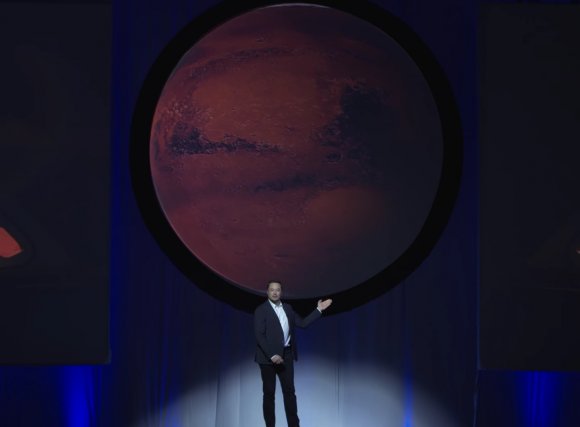
These include the costs of sending people and payloads to Mars, the technical details of the rocket and vehicle that would be making the trip, and possible cost breakdowns and timelines. But of course, he also addresses the key philosophical questions – “Why go?” and “Why Mars?”
Addressing this first question is one of the most important aspects of space exploration. Remember John F. Kennedy’s iconic “We Choose to go to the Moon” speech? Far from just being a declaration of intent, this speech was a justification by the Kennedy administration for all the time, energy, and money it was committing to the Apollo program. As such, Kennedy’s speech stressed above all else why the goal was a noble undertaking.
In looking to Mars, Musk struck a similar tone, emphasizing survival and humanity’s need to expand into space. As he stated:
“I think there are really two fundamental paths. History is going to bifurcate along two directions. One path is we stay on Earth forever, and then there will be some eventual extinction event. I do not have an immediate doomsday prophecy, but eventually, history suggests, there will be some doomsday event. The alternative is to become a space-bearing civilization and a multi-planetary species, which I hope you would agree is the right way to go.”
As for what makes Mars the natural choice, that was a bit more of a tough sell. Granted, Mars has a lot of similarities with Earth – hence why it is often called “Earth’s Twin” – which makes it a tantalizing target for scientific research. But it also has some rather stark differences that make long-term stays on the surface seem less than appealing. So why would it be the natural choice?
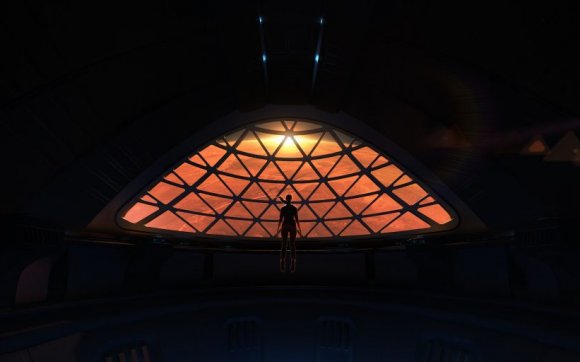
As Musk explains, proximity has a lot to do with it. Sure, Venus is closer to Earth, getting as close as 41 million km (25,476,219 mi), compared to 56 million km (3,4796,787 mi) with Mars. But Venus’ hostile environment is well-documented, and include a super-dense atmosphere, temperatures hot enough to melt lead and sulfuric acid rain! Mercury is too hot and airless, and the Jovian moons are very far.
This leaves us with just two options for the near-future, as far as Musk is concerned. One is the Moon, which is likely to have a permanent settlement on it in the coming years. In fact, between the ESA, NASA, Roscosmos, and the Chines National Space Administration, there is no shortage of plans to build a lunar outpost, which will serve as a successor to the ISS.
But compared to Mars, it is less resource rich, has no atmosphere, and represents a major transition as far as gravity (0.165 g compared to 0.376 g) and length of day (28 days vs. 24.5 hours) are concerned. Herein lies the greatest reason to go to Mars, which is the fact that our options are limited and Mars is the most Earth-like of all the bodies that are currently accessible to us.
What’s more, Musk makes allowances for the fact that colonists could start kick-starting the terraforming process, to make it even more Earth-like over time. As he states (bold added for emphasis):
“In fact, we now believe that early Mars was a lot like Earth. In effect, if we could warm Mars up, we would once again have a thick atmosphere and liquid oceans. Mars is about half as far again from the Sun as Earth is, so it still has decent sunlight. It is a little cold, but we can warm it up. It has a very helpful atmosphere, which, being primarily CO2 with some nitrogen and argon and a few other trace elements, means that we can grow plants on Mars just by compressing the atmosphere.
“It would be quite fun to be on Mars because you would have gravity that is about 37% of that of Earth, so you would be able to lift heavy things and bound around. Furthermore, the day is remarkably close to that of Earth. We just need to change the populations because currently we have seven billion people on Earth and none on Mars.”
Naturally, no mission can be expected to happen without the all-important vehicle. To this end, Musk used the annual IAC meeting to unveil his company’s plans for the Interplanetary Transport System. An updated version of the Mars Colonial Transporter (which Musk began talking about in 2012), the ITS will consist of two main components – a reusable rocket booster and the Interplanetary Spaceship.
The process for getting to Mars with these components involves a few steps. First, the rocket booster and spaceship take off together and the spaceship is delivered into orbit. Next, while the spaceship assumes a parking orbit, the booster returns to Earth to be reloaded with the tanker craft. This vehicle is the same design as the spaceship, but contains propellant tanks instead of cargo areas.
The tanker is then launched into orbit with the booster, where it will rendezvous with the spaceship and refuel it for the journey to Mars. Overall, the propellant tanker will go up anywhere from three to five times to fill the tanks of the spacecraft while it is in orbit. Musk estimates that the turnaround time between the spacecraft launch and the booster retrieval could eventually be as low as 20 minutes.
This process (if Musk gets its way) would expand to include multiple spaceships making the journey to and from Mars every 26 months (when Mars and Earth are closest together):
“You would ultimately have upwards of 1,000 or more spaceships waiting in orbit. Hence, the Mars Colonial fleet would depart en masse. It makes sense to load the spaceships into orbit because you have got 2 years to do so, and then you can make frequent use of the booster and the tanker to get really heavy reuse out of those. With the spaceship, you get less reuse because you have to consider how long it is going to last—maybe 30 years, which might be perhaps 12–15 flights of the spaceship at most.”
In terms of the rocket’s structure, it would consist of an advanced carbon fiber exterior surrounding fuel tanks, which would rely on an autogenous pressurization system. This involves the fuel and oxygen being gasified through heat exchanges in the engine, which would then be used to pressurize the tanks. This is a much simpler system than what is currently being used for the Falcon 9 rocket.
The booster would use 42 Raptor engines arranged in concentric rings to generate thrust. With 21 engines in the outer ring, 14 in the inner ring, and seven in a center cluster, the booster would have an estimated lift-off thrust of 11,793 metric tons (13,000 tons) – 128 MegaNewtons – and a vacuum thrust of 12,714 metric tons (14,015 tons), or 138 MN. This would make it the first spacecraft where the rocket performance bar exceeds the physical size of the rocket.
As for the spacecraft, the designs calls for a pressurized section at the top with an unpressurized section beneath. The pressurized section would hold up to 100 passengers (thought Musk hopes to eventually increase that capacity to 200 people per trip), while all the luggage and cargo necessary for building the Martian colony would be kept in the unpressurized section below.
As for the crew compartments themselves, Musk was sure to illustrate how time in them would not be boring, since the transit time is a long. “Therefore, the crew compartment or the occupant compartment is set up so that you can do zero-gravity games – you can float around,” he said. “There will be movies, lecture halls, cabins, and a restaurant. It will be really fun to go. You are going to have a great time!”
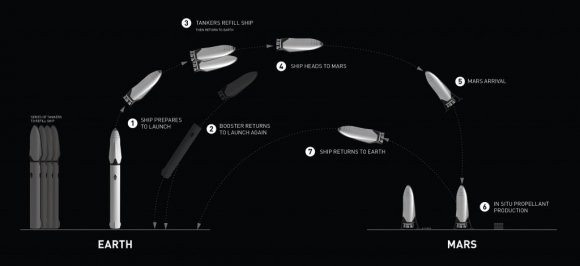
Below both these sections, the liquid oxygen tank, fuel tank and spacecraft engines are located. The engines, which would be directly attached to the thrust cone at the base, would consists of an outer ring of three sea-level engines – which would generate 361 seconds of specific impulse (Isp) – and an inner cluster of six vacuum engines that would generate 382s Isp.
The exterior of the spacecraft will also be fitted with a heatshield, which will be composed of the same material that SpaceX uses on its Dragon spacecraft. This is known as a phenolic-impregnated carbon ablator (PICA), which SpaceX is on their third version of. In total, Musk estimates that the Interplanetary Spaceship will be able to transport 450 tons of cargo to Mars, depending upon how many times the tanker can refill the craft.
And, depending on the Earth-Mars rendezvous, the transit time could be as little as 80 days one-way (figuring for a speed of 6km/s). But with time, Musk hopes to cut that down to just 30 days, which would make it possible to establish a sizable population on Mars in a relatively short amount of time. As Musk indicated, the magic number here in 1 million, meaning the number of people it would take to establish a self-sustaining colony on Mars.
He admitted that this would be a major challenge, and could as long as a century to complete:
“If you can only go every 2 years and if you have 100 people per ship, that is 10,000 trips. Therefore, at least 100 people per trip is the right order of magnitude, and we may end up expanding the crew section and ultimately taking more like 200 or more people per flight in order to reduce the cost per person. However, 10,000 flights is a lot of flights, so ultimately you would really want in the order of 1,000 ships. It would take a while to build up to 1,000 ships. How long it would take to reach that million-person threshold, from the point at which the first ship goes to Mars would probably be somewhere between 20 and 50 total Mars rendezvous—so it would take 40–100 years to achieve a fully self-sustaining civilization on Mars.”

When the ITS is ready to launch, it will do so from Launch Pad 39A at the Kennedy Space Center in Florida, which SpaceX currently uses to conduct Falcon 9 launches from. But of course, the most daunting aspect of any colonization effort is cost. At present, and using current methods, sending upwards of 1 million people to Mars is simply not affordable.
Using Apollo-era methods as a touchstone, Musk indicated that the cost to go to Mars would be around $10 billion per person – which is derived from the fact that the program itself cost between $100 and $200 billion (adjust for inflation) and resulted in 12 astronauts setting foot on the Moon. Naturally, this is far too high for the sake of creating a self-sustaining colony with a population of 1 million.
As a result, Musk claimed that the cost of transporting people to Mars would have to be cut by a whopping 5 million percent! Musk’s desire to lower the costs associated with space launches is well-known, and is the very reason he founded SpaceX and began developing reusable technology. However, costs would need to be lowered to the point where a ticket to Mars would cost about the same as a median house – i.e. $200,000 – before any trips to Mars could happen.
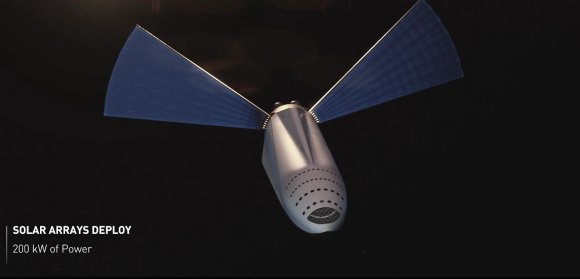
As to how this could be done, several strategies are outlined, many of which Musk and space agencies like NASA are already actively pursuing. They include full Reusability, where all stages of a rocket and its cargo module (not just the first stage) would have to be retrievable and reusable. Refueling in Orbit is a second means, which would mean the spacecraft would not have to carry all the fuel they need with them from Earth.
On top of that, there would have to be the option for propellant Production on Mars, where the spaceship will be able to refuel at Mars to make the return trip. This concept has been explored in the past for lunar and Martian missions. And in Mars’ case, the presence of atmospheric and frozen CO², and water in both the soil and the polar ice caps, would mean that methane, oxygen and hydrogen fuel could all be manufactured.
Lastly, there is the question of which propellant would be best. As it stands, there are there basic choices when it comes – kerosene (rocket fuel), hydrogen, and methane. All of these present certain advantages and can be manufactured in-situ on Mars. But based on a cost-benefit breakdown, Musk claims that methane would be the most cost-effective propellant.
As always, Musk also raised the issue of timelines and next steps. This consisted of a rundown of SpaceX’s accomplishments over the past decade and a half, followed by an outline of what he hopes to see his company do in the coming years and decades.
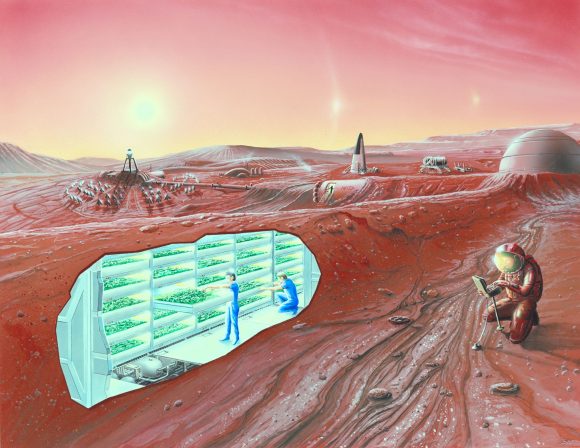
These include the development of the first Interplanetary Spaceship in about four years time, which will be followed by suborbital test flights. He even hinted how the spacecraft could have commercial applications, being used for the rapid transportation of cargo around the world. As for the development of the booster, he indicated that this would be a relatively straightforward process since it simply involves scaling up the existing Falcon 9 booster.
Beyond that, he estimated that (assuming all goes well) a ten-year time frame would suffice for putting all the components together so that it would work for bringing people to Mars. Last, but not least, he offered some glimpses of what could be accomplished with ITS beyond Mars. As the name suggests, Musk is hoping to conduct missions to other destination in the Solar System someday.
Given the opportunities for in-situ fuel production (thanks to the abundance of water ice), the moons of both Jupiter and Saturn were mentioned as possible destination. But beyond moons like Europa, Enceladus, and Titan (all of which were mentioned), even destinations in the trans-Neptunian region of the Solar System were indicated as a possibility.
Given that Pluto also has an abundance of water ice on its surface, Musk claimed that a refueling depot could be built here to service missions to the Kuiper Belt and Oort Cloud. “I would not recommend this for interstellar journeys,” he admitted, “but this basic system—provided we have filling stations along the way—means full access to the entire greater solar system.”
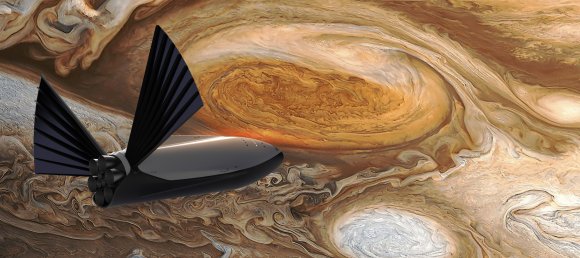
The publication of this paper, many months after Musk presented the details of his plan to the annual IAC meeting, has naturally generated both approval and skepticism. While there are those who would question Musk’s timelines and his ability to deliver on the proposals contained within, others see it as a crucial step in the fulfillment of Musk’s long-held desire to see the colonization of Mars happen in this century.
To Scott Hubbard, it serves as a valuable contribution to the history of space exploration, something that future generations will be able to access so they can chart the history of Mars exploration – much in the same way NASA archival materials are used to study the history of the Moon landing. As he remarked:
“In my view, publishing this paper provides not only an opportunity for the spacefaring community to read the SpaceX vision in print with all the charts in context, but also serves as a valuable archival reference for future studies and planning. My goal is to make New Space the forum for publication of novel exploration concepts-particularly those that suggest an entrepreneurial path for humans traveling to deep space.”
Elon Musk is no stranger to thinking big and dreaming big. And while many of his proposals in the past did not come about in the time frame he originally specified, no one can doubt that he’s delivered so far. It will be very exciting to see if he can take the company he founded 15 years ago for the sake of fostering the exploration of Mars, and use it instead to lead a colonization effort!
Update: Musk tweeted his thanks to Hubbard for the publication and has indicated that there are some “major changes to the plan coming soon.”
And be sure to check out this video of Musk’s full speech at the 67th annual meeting of the IAC, courtesy of SpaceX:
Further Reading: New Space

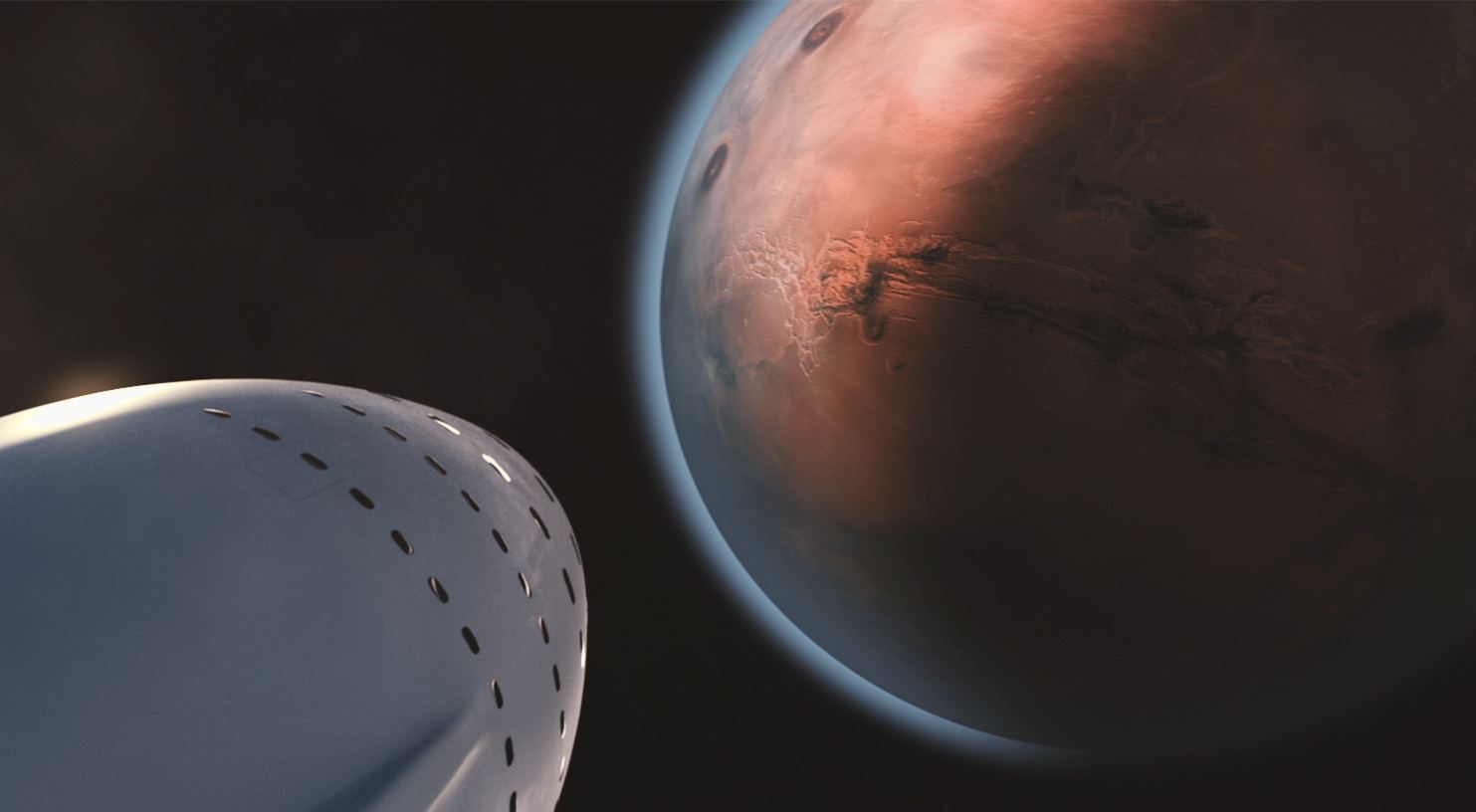
These are not details! It’s a wish list. Given the millions of human years experience in human space flight associated with various global space agencies and nations, is Elon Musk seriously proposing that he can solve getting to Mars with a few hundred engineers?
Apart from 1950’s British Interplanetary society details on the rocketry (which reveal horrendouns problems as is), he offers no details, at all, on the literally thousands of issues otherwise arising.
What’s so dire about Elon Musk and Space X is that they are confusing the public regarding current plausible routes to Mars – so much so that he’s a wrecking ball that will actually delay going there because his ideas are generations of space exploration away.
And of course he knows this – because this isn’t about going to Mars (it may eventually be) – rather it’s about publicity stunts to win contracts.
The good thing about Elon Musk and his plans: so far he has delivered, with delays but delivered none the less.
For all you out there thinking this is fiction and not possible: He can’t go into detail in an hour long speech about rocket science but he is himself an excellent engineer and I bet most of the issues you can imagine, he has already a preliminary solution in his pocket. So engineering the ITS is doable, SpaceX has even shown working prototype tanks and methane engines.
From a financial standpoint it’s more difficult task, but if you watch his speech Elon outlines this too. It’s not gonna be ‘100 colonist dump to Mars’ and see who can die the slowest on first flight. The first couple of missions will be PublicPrivatePartnership, maybe launching a crew of 5-10 with a lot of equipment and triple safety measures and return trip to Mars. Maybe launching his fuel-tanker a couple times to the ISS or the new NASA depot. Maybe launching an internet constellation of thousands of satellites with a few booster starts. With reuseability and Elon willing to pump a hell lot of funds for development into the system and everyone (Space Agencies, Satellite Companies, Private Tourists) can jump on board for a bargain and help to get to the goal of colonizing Mars later on.
Those plans are true and well thought out.